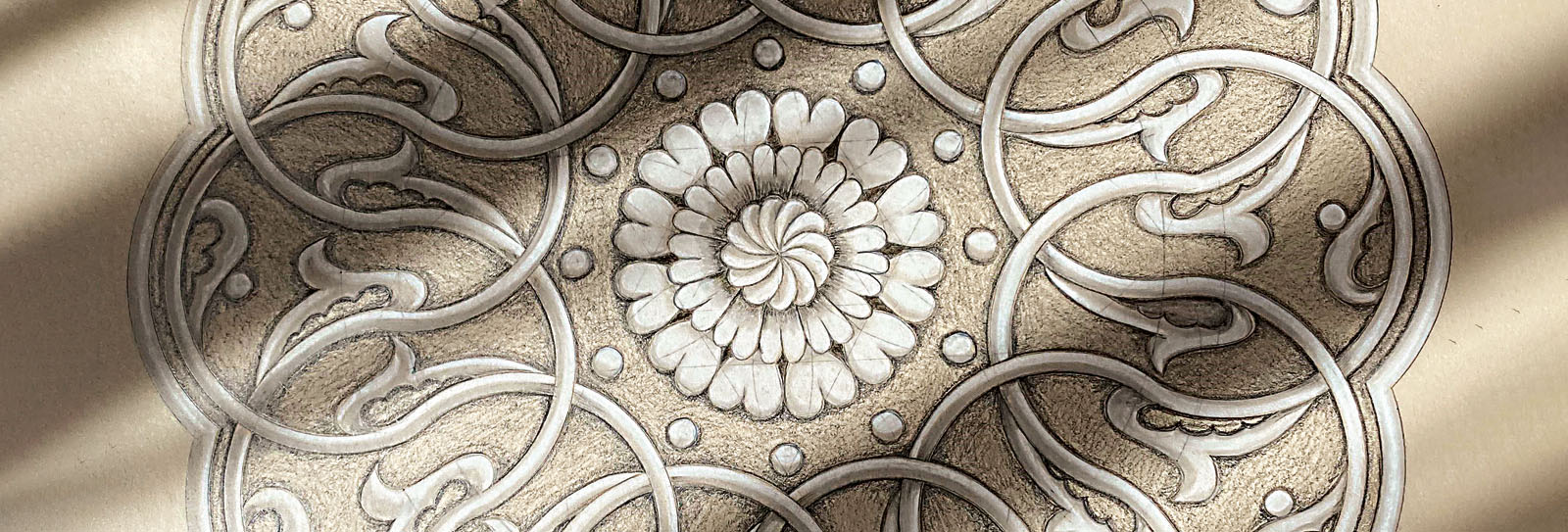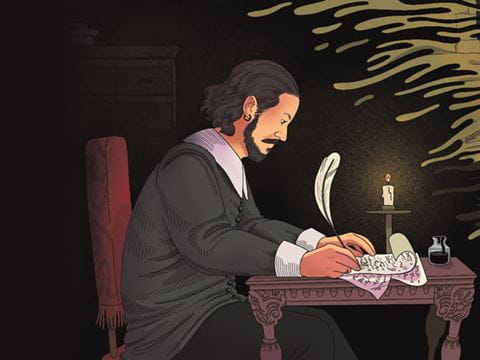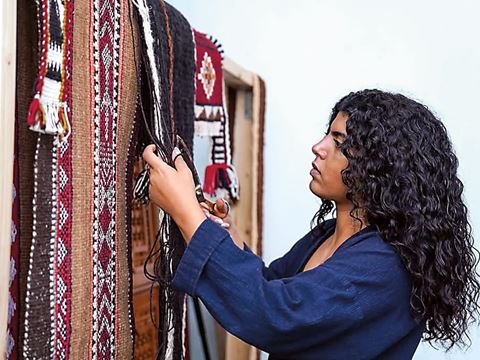
Create Beautiful Ottoman Empire Art With Rüstem Pasha Rosette
Originally designed for tiles adorning the mosque in Istanbul commissioned in the 16th century by Ottoman Grand Vizier Rustem Pasha, this 12-fold rosette combines geometry with plant and flower motifs to achieve a centrifugal, undulating, harmonious composition.
Rüstem Pasha served as Grand Vizier of the Ottoman Empire under Sultan Süleyman, and in 1563 he commissioned architect Mimar Sinan to build a mosque in Rüstem’s name near Istanbul’s Grand Bazaar. Now one of the city’s historic sites, Rüstem also commissioned for it a dazzling array of ceramic tiles painted with subtle and sophisticated patterns
In this fourth installment in our series, we recreate one of these tile patterns, a 12-fold composition that, in several variations, decorates the spandrels and dado around the interior. It is comprised of four continuous spirals woven into a radial rosette. The structure beneath its curvilinear geometry is a six-fold division of the circle, which was also used in installments one and three in this series.
Motifs comprise abstract palmettes, stylized flowers, within decorative patterns. Motifs of local plant life distinguish reginal styles from one another. The designs reflect thus a continuum of the surrounding nature.
The leaf-shaped motifs along the interwoven lines of the rosette are known as Rumi motifs, a reference to Asiatic Rome, that date back to the fourth century BCE as well as later stylistic developments by both Uyghurs in the ninth century CE and the Seljuks in the 11th century CE.
A floral motıf, known as a penç, deriving from the Persian penj berg (five petals), fills the center of the composition. It is rendered here as three concentric rings, comprised of two outer rings of 12 double-lobed petals and a central curvilinear pattern, also of 12 petals. This motif is part of the Hatayı decorative canon that was introduced to Anatolia from central Asia from origins found in Old Uyghur ceramics. The name Hatayı is associated with Herat, Afghanistan, the cultural center of the Timurids and a key trading station along the trans-Asian routes that became known as the Silk Road.
The composition has been skillfully painted onto Iznik tiles, named after the town of Iznik that nestles on a lakeside not far from Istanbul. It was there that in the early 16th century an “Imperial ware,” now called Iznik, was developed using a fritware (glass) body and high-quartz content. The extremely durable results are unaffected by water, moisture, chemicals and temperature changes, and under their protective glaze, their colors have not faded over centuries.
The first stage in producing this masterpiece in ceramic was to draw the pattern on paper. Then the lines were pierced with tiny holes, through which the design could be transferred onto the tile with pigment ready to be hand painted before firing in the kiln.
The curvilinear, biomorphic form is created using a combination of straightedge, compass and freehand drawing. There are three key design elements to consider: spiral, symmetry and balance.
In classical Islamic as well as many other world art traditions, biomorphic designs are structured around a spiral, and from this the motifs and leaves sprout. The movement of nature inspires this unbroken flow of the spiral. It has no hard corners, and the curves are sweeping and gentle. As the spiral advances, it radiates secondary spirals, which in turn radiate others, and soon the page is overgrown. The spiral blossoms from its source like a plant from a seed growing toward the light. This centrifugal movement reflects the progression of creation, moving toward infinity.
Once a section of spirals is drawn, they are reflected and repeated to fill a page, a wall or a dome. In so doing, symmetry is fundamental to harmonious design: It exemplifies completeness, perfection and the search for unity.
The decorative designs tessellate across the surface with an even rhythm and texture, with no part taking precedence. The designs oscillate evenly, an effect created by the repetition and arrangements of the motifs.
Because the act of drawing sacred patterns has often been considered an act of meditation, before creating a work the artisan would make sure the process itself was being approached with adab (etiquette). In addition to ablutions and meditation, this could include making sure all affairs were in order, the mind is empty of matters of the world and the body was relaxed and in flow.
1
- Across the midpoints of the page, draw a horizontal line. Measure its midpoint and, using the compass, inscribe a circle that fills 2/3 of the page.
- Retaining the same radius, place the compass where the circle intersects the horizontal line on the right. Draw a circle. Do the same on the left side.
- Place the compass on each of the four points where the circles meet the circle. Use the intersection points to draw four more circles so that there are now six circles around the first circle.
- Draw the radial lines (white) by aligning the straightedge with the tips of the petals and cross the centerpoint.

2
- Draw two encompassing circles by placing the compass point in the center, and open the compass to the intersections indicated.

3
- Adjust the compass radius to match the distance between the two smaller circles (red arrow).
- Using this measurement draw 12 circles around the circumference of the circle marked turquoise.

4
- Align the straightedge with the intersections of the curves, marked in white, and prepare to mark 12 new radial divisions in turquoise.
- Place the compass point on the turquoise intersections and adjust the compass lead to meet the ends of the red curves. Then draw curves that join up the spirals.
- Repeat the outer curves, but this time expand the compass proportionally to create a channel. And repeat the process for the small inner curves, again aligning the compass lead with the ends of the outer curves.

5 and 6
- Erase the overs and unders to weave the spirals together. Note the rotational order in which the weave is achieved.


7 and 8
- Notice the four interlocking spirals.


9 and 10
- Draw the Rumi motifs onto the spirals in one of the sections. Copy these motifs with a soft pencil on tracing paper. Use this tracing paper to pounce the design into
the remaining 11 sections.


11
- Draw a hexagram inside the center circle by drawing two equilateral triangles in the center circle.

12
- Inscribe a circle inside the hexagon created by the hexagram.
- Inside this circle draw another equilateral triangle (purple) and then smaller circle (green) inside this.

13 and 14
- Use these circles to proportion the concentric layers of petals that create the penç motif.


You may also be interested in...

Stratford to Jordan: Shakespeare’s Echoes of the Arab World
Arts
History
Shakespeare’s works are woven into the cultural fabric of the Arab world, but so, too, were his plays shaped in part by Islamic storytelling traditions and political realities of his day.
Spotlight on Photography: Drinking in Türkiye’s Coffee Culture
Arts

Al Sadu Textile Tradition Weaves Stories of Culture and Identity
Arts
Across the Arabian Gulf, the traditional weaving craft records social heritage.